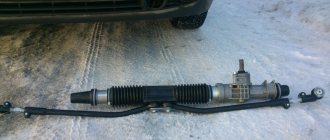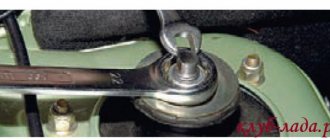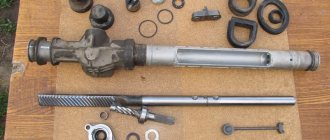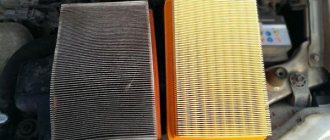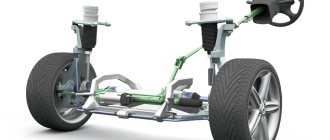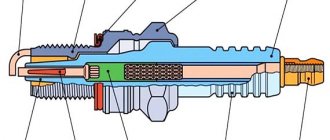The steering mechanism of a modern car has become noticeably more complex and technologically advanced compared to analogues that were actively used previously. At first, the steering was equipped with power steering, later versions with power steering appeared. Today, combined systems are increasingly common, when hydraulics, mechanics and electronics are actively involved.
One way or another, many passenger cars (both with hydraulic booster or electric booster, and without such solutions) invariably use rack-and-pinion steering. At the same time, one of the main components of such steering remains the steering rack. The quality of operation of this unit directly affects the comfort of driving, steering efficiency, and safety.
Next we will look at what a steering rack is, how it works and how it works. Also, within the framework of this article, we will study what signs of a broken steering rack you should definitely pay attention to, how to check the steering rack, how to repair the steering rack, etc.
Steering: types of steering racks and operating principle
Let's start with the fact that since the appearance of the first cars, the rack and pinion mechanism has already been actively used in the steering device. At the same time, the cars were slow; the driver did not apply much force to the steering wheel to make turns or turn around.
However, later cars became heavier, more powerful and faster, the wheels became wider and smaller in size. Of course, the steering effort also increased. To compensate, they began to increase the diameter of the steering wheel, reduce the gear train, change the transmission mechanisms themselves, etc.
Ultimately, it became clear that the steering rack, even taking into account the existing shortcomings, is still the best mass option in terms of technology and production costs. Subsequently, by equipping such a rack and pinion mechanism with a hydraulic booster, it was possible to obtain an optimal solution for a number of indicators.
As a result, passenger cars have the following types of steering racks:
- steering rack without power steering (on old and budget cars);
- steering rack with hydraulic booster (power steering);
- electric power steering rack (EPS);
The last two types are actively used today on mid- and high-class models. Also on luxury cars you can find combined systems (electric power steering).
This scheme means that a hydraulic amplifier works in tandem with an electric amplifier controlled by complex electronics. This allows you to dynamically and flexibly change steering settings depending on specific conditions, as well as taking into account the individual preferences of the driver.
For example, at high speed you can “heavier” the steering wheel, improve feedback, make the steering wheel “light” in a parking lot, and also change some other parameters and characteristics of the steering. In any case, regardless of the complexity of the system itself, the main element remains the steering rack. Now let's look at the types of steering racks and features in more detail.
- So, the main purpose of the steering rack is to convert and transmit force from the steering wheel to the steering rods. In fact, the steering rack is responsible for converting the movement of the steering wheel into turns of the steered wheels in the horizontal plane.
This transformation is possible due to the fact that the rack has a worm gear, to which the force is transmitted from the steering column gear. This worm gear transmits force to the toothed part of the rack.
The general structure of the steering rack is as follows:
- Steering rack housing/housing (usually made of aluminum) to protect the steering rack;
- The gear (worm) rotates from the steering column and is connected to the steering column through a bearing;
- A steering rack or toothed shaft having a section of teeth that mesh with a gear. The shaft and gear are made of durable steel, the top layer of the parts is extremely wear-resistant.
- Springs to ensure reliable fixation and tight engagement;
- Limiters on the range of motion of the shaft in the form of a cuff on one side and a steering rod bushing on the other side.
To make it clear, when the driver turns the steering wheel, through the shaft in the steering column, force is first transmitted to the worm gear (worm), as a result of which the rack mounted in the housing (steering rack shaft) moves left or right. In turn, steering rods are attached to the ends of the shaft.
Also, depending on the type, a power steering system may be attached to the rack. Simply put, these are hydraulic lines and a pair of cylinders, which, due to filling with oil, move the steering rack synchronously with the movement of the steering wheel.
If you don’t apply force to the steering wheel, there is no pressure on the shaft. In the case of an electric power steering system, sensors and a servomechanism (electric motor) are attached to different sections of the rack depending on the design features (on the housing, on the shaft, etc.).
- As for the mechanical rack, it is a simple design that directly transfers the force from the steering wheel to the wheels. In terms of feedback, this is the best solution, since there are no intermediate amplifiers. This design is also reliable and simple, but that’s where the advantages end. The fact is that driving a car with such a steering mechanism is more difficult and difficult, especially if you need to turn the wheels on a stationary car. Shocks and vibrations from the wheels are also transmitted to the steering wheel.
For this reason, this type of steering mechanism is found exclusively on old cars (for example, discontinued domestic VAZ models, foreign cars from the 70-80s, etc.) or on new cheap cars produced for markets in developing countries (for example, ZAZ “Sens” model).
- In turn, a hydraulic rack (rack with power steering) is the most common type of steering. Simply put, a power steering rack works in such a way that when the steering wheel is turned, the gear shaft inside the rack housing “pushes” oil supplied from the power steering pump under pressure. As a result, the driver does not exert much effort on the steering wheel.
The disadvantages include the fact that the design of such a rack is more complex than a simple mechanical analogue. First, the power steering pump connected to the engine takes away engine power and may fail. The power steering also requires periodic maintenance (at a minimum, the power steering oil needs to be changed). The presence of liquid under pressure inside the system also implies complete tightness, which entails the need to use a large number of gaskets, seals, seals, etc.
One way or another, the rack with power steering is actively used on passenger cars, SUVs, trucks and other types of wheeled vehicles. The system has been time-tested and has proven itself to be quite reliable. This solution provides high-quality amplification and allows you to achieve good feedback.
This allows you to drive your car efficiently and safely at different speeds, and also not experience difficulties when parking. As for reliability, in practice, a power steering pump can last more than one hundred thousand kilometers, and a rack with power steering can easily travel at least 100-150 thousand km. without repairs or maintenance.
- A rack with electric power steering (EPS) was originally created as a simpler and cheaper replacement for power steering. In short, this is a regular mechanical rack, but an electric power steering (actually an electric motor) and sensors are separately attached to the steering column or the rack itself. In a nutshell, when you turn the steering wheel, the rotation sensor and a number of other sensors are triggered, which send signals to the ECU. Then the control unit sends a signal to the electric motor, which creates the necessary force.
This system was initially positioned by manufacturers as more compact, cheaper and more convenient compared to power steering. However, in reality, the first versions of the electric power steering had a number of shortcomings (frequent failures and malfunctions, uneven force on the steering wheel when turning in different directions, spontaneous operation of the amplifier, etc.).
Drivers also noted that the feedback of such steering is much worse than versions with power steering. In fact, due to excessive reinforcement, the steering could be too “light” at high speeds, which is very dangerous.
It can also be noted that although in terms of design, the EUR seems simpler to many than the power steering, the reliability and maintainability of such a system turned out to be no higher, and often lower, than that of power steering. The reason is that the electric booster motor itself is difficult to properly repair, a new rack with an electric booster is expensive (sometimes more expensive than a rack with a hydraulic booster), there are fewer repair specialists, etc.
Of course, manufacturers subsequently refined the system, thereby increasing efficiency and reliability. However, a number of issues have still not been resolved, which does not allow the more modern power steering to quickly and confidently displace power steering from the market. It becomes clear that it is the power steering that, until today, has been and remains one of the most reliable, comfortable and proven solutions.
Types of steering racks
- Regular, without amplifiers . It was used back in the 70s - 80s of the last century on 90% of cars. Here, all the effort to turn the steering wheel lies with the driver, there are no amplifiers, and therefore it is not always easy to turn the steering wheel.
- Steering rack with power steering or power steering. In essence, this is the same ordinary rack, only a special pump and a closed circuit with oil seals (where a special fluid is pumped) are added to it, which helps to turn the steering wheel. That is, the driver does not need to exert much effort to turn the steering wheel. This is especially valuable on heavy vehicles (trucks, buses and SUVs).
- Steering rack with EUR or electric power steering. This is a dry type of amplifier, no oil is used here, and the operating principle is completely different. Next to the shaft there is an electric motor with a gear (powered by the on-board network), which helps turn the steering wheel. The ECU gives him orders, he sees where the wheels are deviating and orders the electric motor to help turn.
To exaggerate, the types are divided as follows: - conventional mechanics with 100% use of muscle power, rack and pinion with hydraulic booster and electric booster.
Faults, diagnostics and repair of the steering rack
As mentioned above, there are three main types of steering racks:
- mechanical;
- hydraulic;
- electric;
Combined systems can also be distinguished, however, such solutions are not so widespread and are usually found on expensive high-class cars. One way or another, there are both general problems for all types, and breakdowns that depend on the specific type of steering rack.
In any case, you need to remember that the steering rack is far from the cheapest component. For this reason, when the slightest sign of malfunction appears, the steering rack needs to be diagnosed, after which a decision is made to repair or replace the unit.
First, the driver needs to know the signs of a faulty steering rack. As a rule, the main reason for the failure of this unit is a malfunction of the control electronics, a leak of working fluid, or severe wear of individual parts.
The problem will be indicated by a decrease in the level of working fluid (oil) in the reservoir of the system with hydraulic booster or electric hydraulic booster. If there is no oil leak, then the main signs of rack problems are considered to be:
- a clear change in the force on the steering wheel (usually in the direction of weight);
- the steering wheel turns jerkily, jerkily, the force is uneven;
- at certain points the steering wheel “wedges” (the rack bites);
- When driving over uneven surfaces, a knocking sound is heard and the steering wheel begins to wobble;
- there is noticeable play in the steering column;
If even one of these symptoms appears, a diagnosis is needed. To check on a specific car, you need, at a minimum, to lift the car on a lift, inspect the rack and boots for damage to the body, cracks, and oil leaks.
You also need to evaluate the play in the area of the steering rods, on the steering column; the force on the steering wheel is checked separately, etc. If the system is complex (especially with electric power steering and combined solutions), special attention is paid to electronics, sensors, and servomechanisms (computer diagnostics are often necessary).
It should be remembered that you cannot delay checking the rack. The fact is that even the slightest malfunction will progress, and operating a car with faulty steering is unsafe and can cause an accident.
It is also important to consider that in some cases, at the initial stage, it is possible to stop the destruction of the rail, that is, limit it to repairs. If the problem is ignored, over time the unit will be damaged so badly that only its complete replacement will be necessary, which is quite expensive.
When it is determined that the steering rack is faulty, repair is often possible. To do this, you need to purchase a steering rack repair kit. As a rule, a repair kit for a steering rack involves the possibility of replacing a number of components as part of the overhaul of this unit.
Often, such a kit contains boots, oil seals and o-rings, as well as bearings, support bushings and sliding bushings, springs, etc. Such parts allow you to restore the functionality of the steering rack without the need to completely replace the unit.
However, this solution is only suitable for slats that are naturally worn. If the rack is damaged (broken), the shaft is corroded, there are problems with the spool mechanism, etc., in such a situation, either a complete restoration of the steering rack or replacement with a new unit is necessary. As a rule, the second option is preferable, but it turns out to be noticeably more expensive.
In turn, restoration of the steering rack involves grinding the gear shaft, restoring the teeth, making bushings and oil seals to new sizes, sandblasting the rack body, etc. The quality of work and reliability of such a unit will directly depend on the experience and qualifications of the specialist performing the repair.
How is the steering rack constructed?
— A car’s steering rack is a device whose purpose is to convert the driver’s effort when acting on the steering wheel inside the car, which is necessary to ensure the rotation of the car’s wheels.
— Today there are three types of steering racks, the principles of which differ. Hydraulic steering rack. It is used in almost all passenger cars produced today. Provides fairly comfortable driving, since hydraulic power steering is used, so the driver needs to exert a minimum of effort. Mechanical steering rack. The design of this element is very simple. At one end of the rack there is a gear mechanism that contacts the gear rack. The latter interacts with the steering drive.
Electric steering rack. Its difference from its hydraulic counterpart is that hydraulics are not used. To increase the driver's effort, the car is equipped with a separate electric motor. The design of the steering rack, as well as the principle of its operation, depend on the characteristic features of each car. The steering rack can have an upper or lower location, which also depends on the vehicle model. Overhead steering racks are installed at the rear of the engine and are attached to the car body. Steering racks with a lower location are attached from below, they are connected to the body, subframe or beam.
Useful tips
It should be noted that the main reasons for premature failure of the steering rack are considered to be:
- moisture and dirt getting inside the mechanism;
- high shock loads (driving on bad roads);
- low quality of node service;
First, racks usually fail due to the fact that water and dirt get into the rack through damaged boots in the area where the steering rods are attached. This leads to corrosion and active destruction of the shaft and other parts. As a result, the shaft begins to knock, rack versions with power steering leak, etc. To prevent this from happening, the condition of the steering rod boots must be monitored, since even slight damage to the boot will quickly disable the sensitive mechanism.
We also recommend reading an article about the reasons why the power steering hums, as well as what breakdowns lead to the power steering humming. From this article you will learn about the main malfunctions and reasons why the hydraulic booster howls or the power steering hums, as well as how to diagnose and repair such malfunctions.
Also, the rack usually breaks if the owner does not follow the basic rules of maintenance and operation of this unit. These rules apply to all types of racks, but are more directly related to power steering and similar solutions where working fluid (power steering oil) is poured into the steering rack.
To extend the service life of the unit, you should check the oil every 10-15 thousand km, monitor the level and condition of the oil in the power steering reservoir. Changing the oil in the power steering is recommended every 60-80 thousand kilometers. Also, during operation, the oil should not be dirty, change its color, there should be no foreign impurities in the oil, a burning smell, etc.
If a change in the condition of the oil is noticed, regardless of its service life, it should, at a minimum, be completely replaced. In a situation where the oil is old, the power steering does not work correctly and replacement does not help solve the problem, in-depth diagnostics of the steering rack, power steering pump and other elements of the system are necessary.
As for operation, you should not leave the car in the parking lot with the wheels turned out, and it is also forbidden to hold the steering wheel in the extreme position while turning for more than 5 seconds. In the first case, when the engine starts with the wheels turned, the rack with power steering wears out greatly, and in the second, the oil in the rack quickly overheats. Also, when driving, you should carefully cross uneven surfaces, and also reduce your speed to a minimum when crossing curbs or completely abandon this practice.
Even before driving in the cold season, it is also advisable to warm up the power steering by turning the steering wheel at low speed one or half a turn to the left and right. However, experts do not recommend doing this on a stationary car.
Troubleshooting steering rack
Steering rack malfunctions are quite common, since this unit and the entire steering system on domestic roads are subject to increased loads. You can detect a broken rack yourself, based on a number of signs:
If these symptoms of rack failure appear, it is recommended not to delay dismantling the steering gear for inspection and troubleshooting in order to minimize repair costs.
- it has become harder to turn the steering wheel, or it periodically bites (difficult rotation is observed only periodically in certain positions of the steering wheel);
- there is a knock from the front suspension, which clearly “irradiates” into the steering wheel;
- The power steering pump is noisy;
- play in the steering wheel, which means there is play in the rack;
- oil leakage from the steering rack, which is often accompanied by a noticeable increase in the steering force and noise arising during this action.
The manifestation of such signs indicates that the steering rack device
somewhere is broken and this mechanism requires diagnostics and further repair.
What's the result?
Taking into account the information provided, it becomes clear that the steering rack is the most important element in the steering control of many cars. Comfort and safety depend on the quality and efficiency of the slats. However, many steering racks are equipped with a power steering, which means the need for periodic checks and regular maintenance (especially in the case of power steering).
We also recommend reading the article on how to change the power steering oil yourself. From this article you will learn what kind of oil to pour into the power steering, what needs to be taken into account when selecting power steering oil, as well as how to change the oil in the power steering and what features you should pay attention to as part of this procedure.
Finally, we note that there should be no failures in the operation of the steering; any deviations from the norm are unacceptable and are the basis for professional diagnostics, repair or replacement of a damaged or worn-out unit. At the same time, timely measures taken taking into account the signs of problems discussed above often make it possible to avoid expensive restoration of the steering rack, replacement of the steering rack with a new one, etc.
The main thing is that all repair and maintenance work is carried out by experienced specialists. Otherwise, malfunctions and steering failures cannot be ruled out, which can lead to serious accidents and other consequences.

